|
Oct
31
2022
|
|
Posted 3 years 50 days ago ago by Admin
|
|
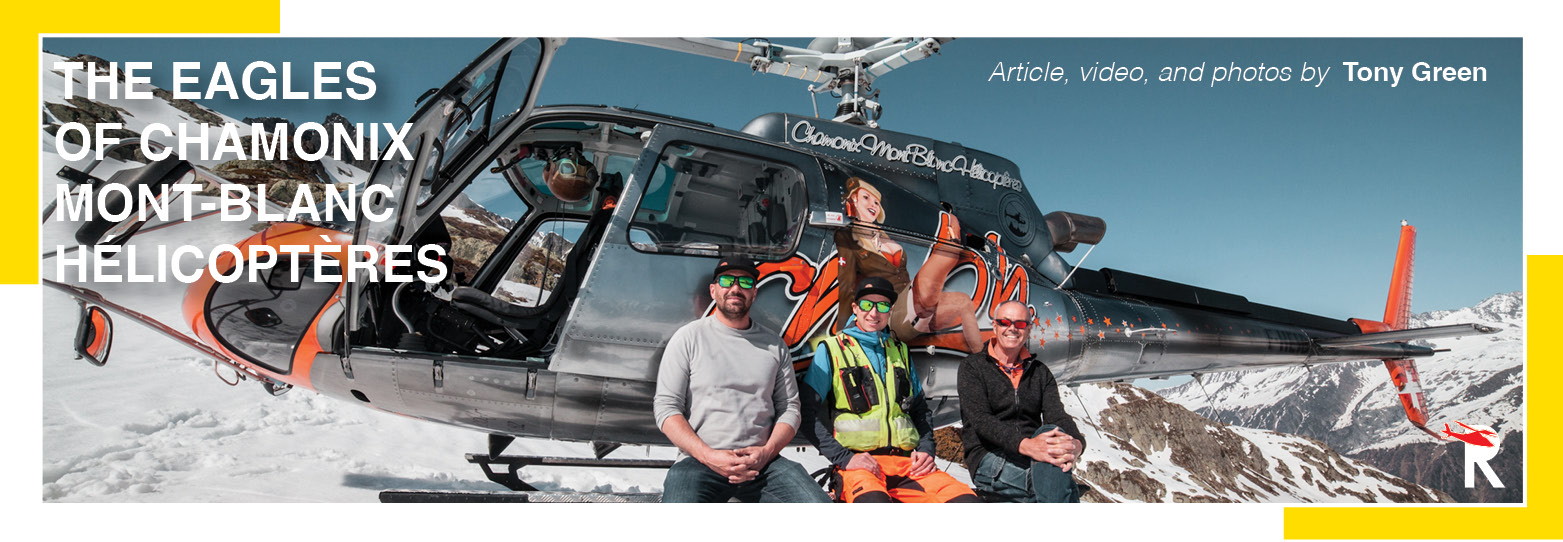
VIEW VIDEO
The Mont-Blanc massif is a majestic range of mountains shared between France, Italy and Switzerland. Culminating at 4,808 meters above sea level, the Mont-Blanc summit is the highest of Western Europe.
It’s a true paradise for mountain lovers as it shows them different climates throughout the year, which makes it a place to visit for all seasons.
Mountains create challenges, such as the altitude, the lack of oxygen, the changing weather, the different surfaces (snow, ice, rocks) and limited accessibility. At the top of some summits, you can find huts for hikers, ski lifts. All these facilities need regular maintenance.
The only sustainable way to access them easily and quickly is to use helicopters. Fortunately, Chamonix Mont-Blanc Hélicoptères (CMBH) is strategically located at the bottom of Glacier of Argentière near Chamonix in Haute-Savoie, France. It was founded in 1992 by pilot and CEO Pascal Brun, who is known by the local community as the pilot with more than 30,000 flight hours.
Nicknamed Le Joker , authorities often call him when the situation is tricky. Therefore, he’s been recognized and awarded for his courage and dedication. Brun has landed on the summit of Mont-Blanc more than 1,000 times.
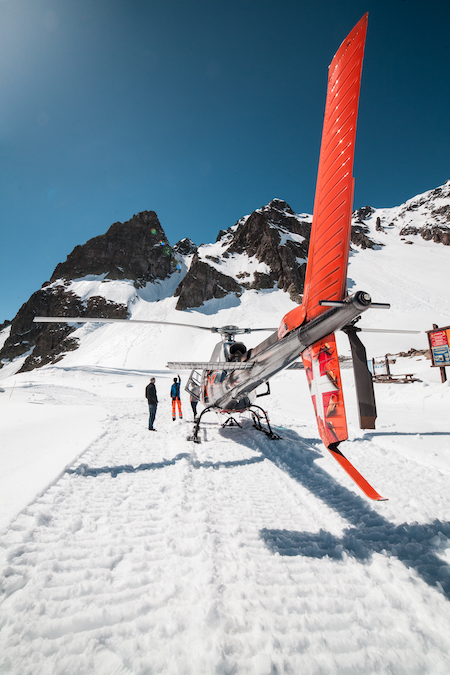
In the early days of CMBH, the iconic sound of its Lama SA-315B could be heard over the Chamonix Valley. Childrens and aviation enthusiasts, looked up to see the elegance of the Brun’s helicopter dancing through alpine reliefs.
Today, the company flies two aircraft: an H125 and an AS 350 B3e, both with beautiful artwork on them. One painting is most meaningful; the H125 has a memorial portrait in memory of Brun's son, Sébastien, who died in a 2011 helicopter crash.
Missions are very varied and experienced pilots get the opportunity to fly load transport, rescue, avalanche control, aerial shots for movies, panoramic flights, and passenger transport.
As an aerial load transport specialist, Brun has made significant contributions to the construction and maintenance of many high-altitude huts. His CMBH team was requested to assist the renovation of “Refuge Vallot” a hut located at an altitude of 4,362 meters. They’ve also worked on “Refuge du Goûter” at 3,835 meters altitude, and the fabulous Aiguille du Midi at 3,842 meters.
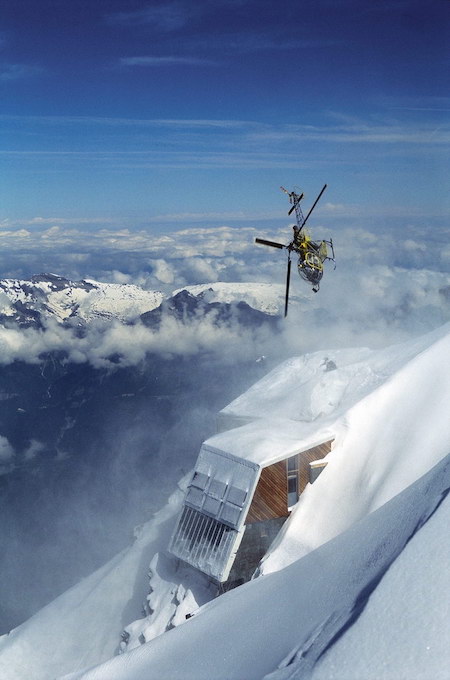
Helicopters are a main machine in mountain work, as they can reach remote sites and disappear without leaving a trace when their work is done. They make round trips in limited time, and can carry material, passengers, and other items to and from the huts. When “time is money,” helicopters save both. Imagine how many days and people it would take to maintain remote, high-altitude huts. A helicopter can reach destinations in minutes, not days. It’s a real game changer.
Even better, helicopters help maintain the fresh-air majesty of the mountains by evacuating trash and septic tanks, or by removing outdated installations that destroy the pristine view.
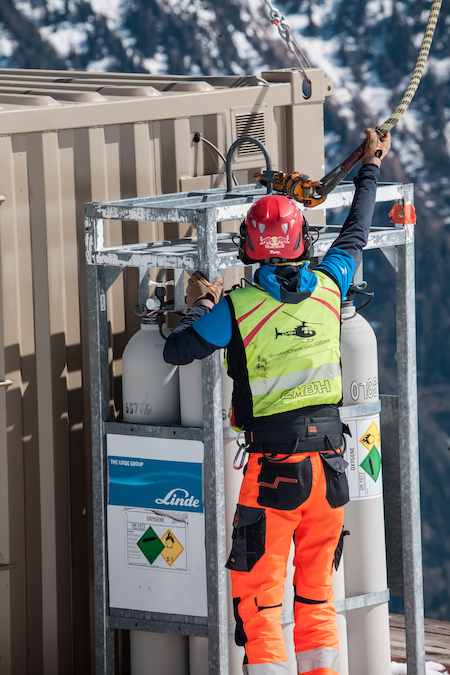
A Day with CMBH
We got the opportunity to accompany CMBH’s team for one day dedicated to the preparation of the summer season. After a great winter season, mountain installations need different kinds of maintenance.
We met very early in the morning for the day’s briefing. It was spring; the air was crisp and the temperature was somewhat chilly. Nadine, who has worked for the CMBH for more than three decades, organizes the agenda and manages the busy schedule of the team and aircraft.
Flight assistants start to take helicopters out of the hangar and prepare equipment for day’s missions.
This morning, it’s all about the control and installation of “Gazex” avalanche-prevention systems. They cause a shock wave through an explosion on the snowpack to destabilize and set in motion a recent accumulation of snow in their starting areas. This greatly reduces the natural triggering of a larger destructive avalanche in the same sector until significant snowfall later. Therefore, it’s a temporary avalanche protection measure.
The team must drop off people at different high altitudes and retrieve them for each installation. It’s quite a tricky exercise, as the places are almost out of access and the snow is half hard, half melted at this time of the year.
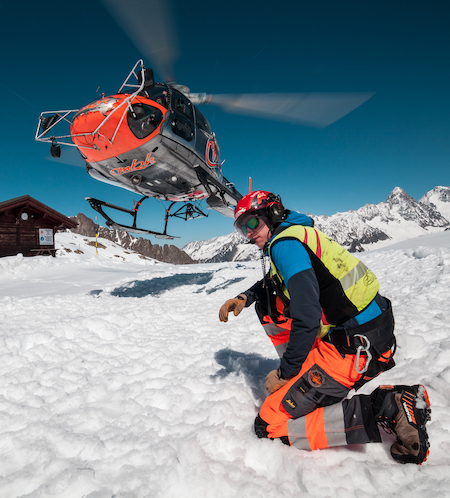
While the technicians on the mountain are managing the Gazex systems, the helicopter goes stand-by in a secured area, patiently waiting for them. When retrieving technicians, the focus is on not putting the helicopter in a dangerous situation as protruding mountainous rocks are abundant. One bad movement and the mission can quickly turn into a nightmare. Fortunately, all pilots and flight assistants have years of experience and are used to these situations. Once technicians are retrieved from a site, it’s time to go on to the next avalanche area.
The flight assistant serves as the pilot’s “third eye” and works to keep technicians safe as they are dropped off and onboarded. They guide the pilot with high-level precision and keep the weight of the helicopter balanced as they define landing areas in high altitudes. Most of the time, the only way to land is by a skate support maneuver.
Each minute counts to complete the landing operation that includes evaluating the terrain and landing zone, guiding during approach, dropping off technicians and equipment, and then taking off safely.
In the middle of the morning, the guardian of the Refuge du Goûter contacts the CMBH team to carry supplies up to them in the afternoon. The second team prepares for the mission as best as can be done in an environment where weather changes fast at different altitudes.
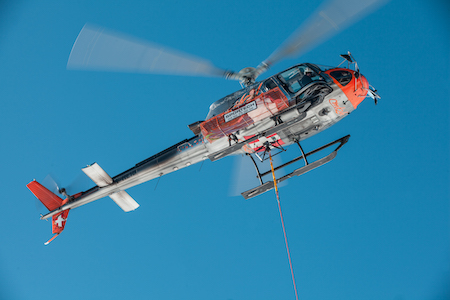
The flight rate per hour is expensive and the team needs to fully coordinate to quickly deliver supplies. It’s a “big bag” load, and the sun is shining. At this season and altitude, the maximum weight the helicopter can carry is 650 kilograms. By comparison, in summer with warm temperatures, the maximum weight is limited to 500 kg.
Brun explains that each delivery is different because each location differs; weather conditions change along with the schedule, as do the nature of material and supplies delivered. Transporting a large metal panel is totally different from flying a cube of concrete or a loaded big bag. The differing length of each sling is also significant and can vary from 10 meters to 125 meters; that makes a big difference for the flight and its aerology analysis.
Our day was fully filled with different types of missions, in addition to some panoramic flights. Each team member had a busy day.
After tidying up and washing the birds in the air-shed, all the team gets together to enjoy a cheese fondue, the local food specialty, in their office near Glacier of Argentière. They benefit from the last sun rays over Mont-Blanc.
The entire team has a strong bond with each other and their mountains. Availability, reactivity, efficiency, and professionalism, all of these with a human touch are the main values of CMBH.
Flying in this hostile, but beautiful, environment takes a lot of know-how and, most importantly, humility. “Nature always wins,'' says Brun.
Today, Pascal’s son, Eliott, carries on the Brun family values he inherited. Here are excerpts from our interview with father and son, along with insights from Pierre Lopez, a flight assistant for more than 10 years.

Pascal Brun, CEO of CMBH and pilot
What are the necessary qualities of a pilot for lifting and aerial work at high altitude?
The most important quality is humility.
Eliott Brun, pilot
What are the potential dangers of helicopter mountain flying?
Mountain flying is as beautiful as it is special. It requires a high level of expertise but also to remain humble in the face of the elements because the mountain will have the last word if we don't listen to it. You have to know how to adapt to the terrain, the wind, and changing conditions.
Surrender should always be an option and one of the most important tips for me is that if we don't feel something, then we shouldn't do it. It is also important, as much as possible, to provide an emergency exit by anticipating what could go wrong, never locking ourselves into questionable weather conditions if we are not sure we can get out. Finally, the key word in the mountains is anticipation and feeling.
What advice would you give to someone who wants to get into this field?
This is not advice specific to the mountain helicopter and logging world, but more of a general life tip. We must remain simple and true, always remember where we come from and that at the beginning we are all driven by this passion for flying and mountain. For me, pilots I admire and respect the most, have all remained true and easy to approach.

A second advice to give would be to never stop believing in it, the time may seem very long to get there, but the pleasure that this work gives is well worth the time spent waiting. Step by step, things come to those who know how to wait, and the greatest success is to end up where we always wanted to be, by having climbed all the stages.
To conclude, I would say that in such a closed and demanding environment as aerial work in the mountains, the greatest value is to remain humble and attentive. Never forget that the mountain will always have the last word, and that you have to know how to treat it with great respect. We are only its guests!
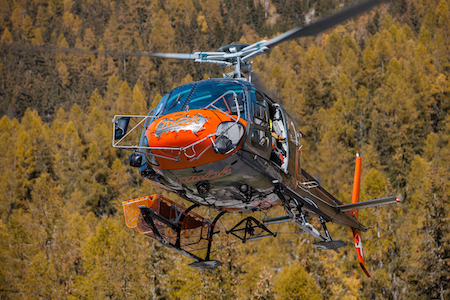
Pierre Lopez, flight assistant
The flight assistant must manage several types of mission, which one requires the most experience and technicality?
I would say that the mission that requires the most technique and experience is the ''winching maneuver. '' The pilot has to have 100% confidence in his winch operator. We are the eyes of the pilots and we must give him all the information necessary for the smooth running of the operation. We must not forget that our job, above all, is teamwork and that trust between pilot and flight assistant is essential.
VIEW CHAMONIX MONT BLANC HELICOPTERS VIDEO
READ CHAMONIX MONT BLANC HELICOPTERS FEATURE STORY
READ MORE ROTOR PRO: https://justhelicopters.com/Magazine
WATCH ROTOR PRO YOUTUBE CHANNEL: https://buff.ly/3Md0T3y
You can also find us on
Instagram - https://www.instagram.com/rotorpro1
Facebook - https://www.facebook.com/rotorpro1
Twitter - https://twitter.com/justhelicopters
LinkedIn - https://www.linkedin.com/company/rotorpro1